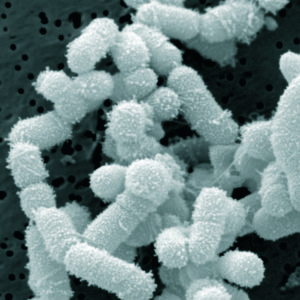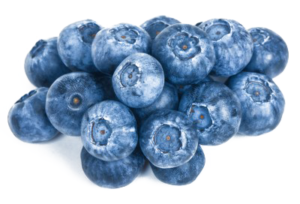 [Please go to updated June 2022 version of this post.]
[Please go to updated June 2022 version of this post.]
(Oct. 2018) Probiotics and sinusitis treatment go hand in hand. In the last few years researchers found that one probiotic (beneficial bacteria) that chronic sinusitis sufferers lack and that treats and cures sinusitis is Lactobacillus sakei. And for many, major improvement may take only days!
The researchers Abreu et al found in their 2012 study that not only do sinusitis sufferers lack L. sakei, they have too much of some other bacteria, and they also don't have the bacteria diversity in their sinuses that healthy people without sinusitis have. In other words, the sinus microbiome (microbial community) is out of whack (dysbiosis). A number of studies since then also found that there is a depletion of some bacterial species, and an increase in "abundance" of other species in those with chronic sinusitis.
Luckily Lactobacillus sakei is found in some foods (such as some brands of live fermented kimchi), some sausage starter cultures (such as B-2), and recently in some probiotic supplements (e.g. Lanto Sinus). One reason it is used in sausage starter cultures is because L. sakei dominates over and inhibits growth of pathogenic bacteria, including Staphylococcus aureus. This post discusses these L. sakei products and other possible probiotic treatments for sinusitis.
Treating sinusitis with beneficial bacteria (rather than with antibiotics, corticosteroid nasal sprays, and surgery) is the future in sinusitis treatment.
BACKGROUND STORY: More than 5 years ago there were no probiotics containing L. sakei. None. So I experimented using a very easy kimchi sinusitis treatment (basically dabbing and smearing kimchi at certain stages of fermentation into my nostrils like a very messy eater) and found that it cured my chronic sinusitis of many years within two weeks. Obviously it contained L. sakei. Then the rest of my family also tried the kimchi treatment and were also quickly cured of chronic sinusitis! It felt miraculous, especially because it was so easy to do.
After 5 years we still feel great! Generally we only need to treat again with a product containing Lactobacillus sakei (we've been using refrigerated Lanto Sinus) after a virus which goes into sinusitis, or if for some other reason we feel like we're sliding into sinusitis. We've improved every year so need to do it less and more minimally.
Because we no longer have chronic sinusitis and can easily treat sinusitis if it occurs with L. sakei, we have NOT taken antibiotics or any other bacteria killing spray or product (such as xylitol) for over 5 years. We do not use cortisone or antihistamine nasal sprays either.
WHEN A TREATMENT WORKS: A number of you have contacted me to report your own progress with various sinusitis treatments. People used terms such as "miraculous", "transformative", and "fabulous" when they had positive results with a product containing L. sakei - and many with major improvement happening within a few days. I’ve also heard from a few people of some other beneficial bacteria species that may treat sinusitis.
When a treatment works, then all sinusitis symptoms go away --sometimes within days, sometimes longer. This includes post nasal drip, sinus headaches, "clogged ears", bad breath, and sinusitis-related coughs. Even tonsil stones! (Please note that trying such products to treat sinusitis is self-experimentation - effects can be positive or negative. One should always be cautious.)
OVERALL RESULTS: The majority of people contacting me with results reported positive results (chronic sinusitis greatly improved or totally gone) from some form of L. sakei treatment. Successes have been reported to me from the USA, Canada, Europe, Australia, New Zealand, and Africa. But since it's from self-experimentation and not a clinical trial, then I don't know the actual percentage of positive results.
Some of the people reporting success have had multiple operations, some currently have deviated septums, some with nasal polyps, and all have had long-standing chronic sinusitis, some for decades. Interestingly, Lactobacillus sakei works best when it is used only when needed, when there are sinus symptoms. Don't use when feeling healthy.
Those same chronic sinusitis sufferers also reported that the same treatments also worked to treat acute sinusitis or sinus infections. It seems that after colds or viruses may develop acute sinusitis again and need re-treatment (apparently the L. sakei frequently doesn't stay in the sinuses from earlier treatments). However, the sinuses do continue improving over time so fewer and more minimal treatments are needed over the years.
Another very small group reported that other probiotic strains helped, and a minority of people reported that nothing has helped and there could be a variety of reasons for this (see below). Some people reported that one product helped, but not another - whether kimchi or a L. sakei product. It also became clear that L. sakei does not treat seasonal allergies or allergy symptoms.
THREE MAIN PRODUCT CATEGORIES: The main categories of products containing live Lactobacillus sakei are:: kimchi (and some sauerkraut), refrigerated products, and frozen products. Note that at this time the FDA does not allow any probiotics to be sold as a medical treatment – they can only be sold as a supplement.
Using the following products to treat sinusitis is self-experimentation (results are unknown and can vary). Always be cautious when testing a new product. (See Sinusitis Treament Summary page for treatment methods.)
KIMCHI - Many people report that kimchi helped them. One person reported a homemade kimchi worked great (he was finally symptom free after 8 years). A few have even mentioned that kimchi has helped sinusitis with fungal problems.
Kimchi brands that people reported helping their chronic sinusitis: Sunja's Kimchi (mild white kimchi and medium spicy cucumber kimchi), Sinto Gourmet brand kimchi, Mama-O's Premium Kimchi, the white Napa kimchi and cabbage kimchi made by Choi's Kimchi Company (in Portland, Oregon), Farmhouse Culture Kimchi (in California), Ozuke Kimchi (in Colorado), Mother-in-law's Kimchi, in the United Kingdom the brand Mr Kimchi, and in Australia Kehoe's Kitchen white kimchi.
(Not all kimchi brands or types of kimchi within brands contain L. sakei - finding one that has it is due to self-experimentation. The kimchi must be live, and not pasteurized. We found that kimchi may contain L. sakei from about day 14 (or earlier) to about 2 to 2 1/2 months (from the day it's made).
When the kimchi contained L. sakei we felt the same or started feeling better within one or 2 days. If we felt more mucusy over the next 2 days, or the acute sinusitis kept getting worse, than it did not contain L. sakei.) Some researchers feel that it's the garlic in kimchi that encourages L. sakei growth.
SAUERKRAUT - Some people improved with sauerkraut made with garlic. Some researchers feel that it's the garlic in kimchi that encourages L. sakei growth, and sauerkraut typically doesn't contain garlic.
REFRIGERATED LACTOBACILLUS SAKEI PRODUCTS – A refrigerated L. sakei product specifically meant for the sinuses is now available. The company Lanto Health has introduced a kimchi derived Lactobacillus sakei product called Lanto Sinus - to be used when needed (when there are symptoms). Lanto Sinus is sold as a dietary supplement, holds up well in the refrigerator, is effective, quick-acting, and easy to use. This high-quality product ships well because it holds up for a while (days) without refrigeration.
People have reported success using it mixed with bottled water (dabbing, smearing, spooning a little in nostrils), or swishing it dry in the mouth. I’ve been a consultant with Lanto Health on this product and have been testing and using this product successfully for over a year (self-experimentation!).
FROZEN LACTOBACILLUS SAKEI PRODUCTS – The main L. sakei products available in many countries throughout the world are various frozen sausage starter cultures. All L. sakei products needing to be kept frozen are generally reliable and effective for sinusitis treatment. They should only be used when needed. But negatives with all frozen L. sakei products are that they must be kept frozen, they don’t hold up well once the package is opened, and they can easily die off during shipping.
Sausage starter cultures include BACTOFERM F-RM-52 (many countries, made by Chr. Hansen), PRIMAL SK NATUR 50 (Europe, made by Van Hees), and BITEC LS-25 (Europe, made by Frusarum). These starter cultures contain 2 types of bacteria (L. sakei and Staphylococcus carnosus) – little is known about S. carnosus, but it is considered non-pathogenic, and no one has reported negative effects from it. B-2, which is only L. sakei (made by Chr Hansen), is available in New Zealand and some EU countries. The starter culture BACTOFERM SM 160 (L. sakei, Staphylococcus carnosus and Debaryomyces hansenii) has also been used successfully for chronic sinusitis. But one should be very cautious because while the third bacteria is considered non-pathogenic, is common in food products, is used commercially to make B12 - it is a yeast species (fungi).
Most use a frozen product by dabbing/smearing or spooning a little of the mixture (L. sakei and bottled water) into the nostrils. Sometimes a side effect on the day the product is used is a dry mouth and throat (and they can be very dry when overused - so it's important to use only a little in a treatment). The person who used the nasal aspirator reported a temporary decrease in her sense of smell.
[NOTE: I personally have overuse concerns (too strong a dose) with using L. sakei in a neti pot or nasal syringe, and so have never used any L. sakei product that way. My personal view: let the little suckers travel up to the sinuses on their own. And they do. And I always start first with the most cautious way to see if that works.]
SOME L.SAKEI ISSUES: I still think of L. sakei as fairly fragile – for example, it is killed off by antibiotics, by oxygen, and it only lives a limited amount of time at room temperature. [For ex.: the culture Bactoferm F-RM-52 package says that it dies off in less than 2 weeks at room temperature - therefore store in freezer.] On the other hand, many different Lactobacillus strains live and multiply in our bodies at 98.6 degrees Fahrenheit - so L. sakei can handle warm temperatures just fine for a while.
Note that the L. sakei in any product can also die off during shipping if it takes too long, it’s too hot (e.g. inside hot postal vehicles in extreme heat), or some other reason. Thus we order 2 day shipping (if possible) and hope for the best. (Note: Consider overnight shipping during 100+degree Fahrenheit heat waves. Also, USPS delivers to mailboxes, while UPS typically delivers to the door.)
WHY DOESN'T L. SAKEI WORK FOR SOME PEOPLE? Some possibilities to explain why some people trying various L. sakei products has not resulted in their sinusitis improving is that perhaps some other "keystone species" (a very important microbial species for a normal healthy community) besides L. sakei is missing in their sinus microbiomes. Or perhaps they have microbes that the L.sakei bacteria cannot overcome.
It is unclear whether the results are different if there are also nasal polyps. Researchers now suspect that those with nasal polyps also have a problem with "primary inflammation". We (modern medicine) know so little about the normal healthy sinus microbiome that there are many unanswered questions.
PROBLEM WITH A PRODUCT SUDDENLY NOT WORKING, OR OVERUSE - Several people reported that a kimchi brand or L. sakei product that originally worked for them suddenly stopped working or not as well, but usually it had been the only product used for a while. There may be a feeling of "imbalance" or on rare occasion some symptoms (e.g. more mucus, sore throat). We think this might be an issue of "too much of certain microbes".
Then we (family members) have found that immediately switching to another product (e.g., from one brand or type of kimchi to another), or from a L. sakei product to kimchi, or swishing an opened capsule (the dry powder) of multi-strain probiotics, or refrigerated L.sakei in the mouth (this last if switching from kimchi) has corrected the situation for us. (Finding what works is self-experimentation, and varies from time to time.). And weeks later, we can use the original product once again. This is also why we only use a product when needed.
BOTTOM LINE: When feeling good or healthy, stop using the L. sakei product. Use L. sakei products sparingly - only as needed (e.g. when developing sinusitis). Using less is better than more over time – probably due to sinus microbial communities improving over the years. L. sakei seems to be necessary for sinusitis treatment for most people (a keystone bacteria), but there are also other important microbes in the sinuses - a whole community.
OTHER PROBIOTICS MAY OR MAY NOT HAVE BENEFICIAL EFFECTS - Rarely some people have reported that multi- strain probiotics (but they did not contain L. sakei) treated their sinusitis. They mixed the powder in the capsules with water and smeared or dabbed the mixture in the nose, or even used it in a saline rinse (this last was rare). Different brands containing different mixtures of bacteria (Lactobacillus and Bifidobacterium) have been mentioned - but all were refrigerated probiotics - so nothing stands out.
On the other hand, other people (including my family members) reported trying various multi-strain probiotics containing various Lactobacillus and Bifidobacterium species in the nostrils and found it did not help sinusitis. However, we found that when we feel a little “imbalanced” – perhaps a cough or mucusy – then swishing the dry powder from one capsule in the mouth and then swallowing it - frequently results in some improvement (perhaps with a cough).
I have concerns with products that also contain titanium dioxide – this is because it may be in nanoparticle form, and recent studies have raised concerns that the nanoparticles can travel to other organs in the body, and are also inflammatory. So read the ingredients!
STILL UNKNOWN: Some multi-strain probiotics now contain L. sakei, but may be problematic if they don’t need refrigeration (e.g. Multi-strain Probiotic by Innovix Labs). L. sakei products typically die after a few weeks without refrigeration, and die when exposed to oxygen (anaerobic). So...while the L. sakei may be alive when the product is produced, is it alive weeks or months later at room temperature?
Also, will a multi-strain probiotic containing both L. sakei and S. salivarius K12 (such as Pro-Kids ENT by Hyperbiotics) help or make things worse for those with sinusitis? S. salivarius K12 has caused problems for some people (scroll down to "Problems With BLIS K12?").
NO EVIDENCE FOR JUST SWALLOWING PROBIOTIC SUPPLEMENTS: Evidence (my family, people writing in, research) so far has been that only directly dabbing/applying probiotics in the nose, or even swishing probiotics in the mouth may help treat sinusitis. I have not found any studies finding that just swallowing a probiotic pill has helped sinusitis (including a 2009 study looking at swallowing L. rhamnosus tablets 2 times daily for 4 weeks).
PROMISING PHAGE THERAPY - Some researchers in the USA and Australia are currently testing phage therapy to see if it could be used as a treatment for chronic sinusitis. A bacteriophage is a virus that infects bacteria, and the name literally means "bacteria eater". Phage therapy is the therapeutic use of bacteriophages to treat bacterial infections. See the June 3, 2016 post Phage Therapy May Help Sinusitis Sufferers for more information.
The authors of one study I posted said that they had found evidence for people having "virus-like particles" in their sinuses, which they thought were bacteriophages.
SNOT TRANSPLANTS IN THE FUTURE? – Currently a “snot transplant” study from healthy persons to sinusitis sufferers is going on in Europe to see if it works as a sinusitis treatment. This possibility may work great, but researchers have the same concerns as with fecal microbial transplants (stool transplant) for the gut. For example, are diseases also being transplanted?
PROBLEMS WITH BLIS K12 ? - Some people (and family members) tried the probiotic BLIS K12 bacteria (also known as Streptococcus salivarius BLIS K12), but found it brought on sinusitis-type symptoms. Scientific research finds it to be an immune booster and it lowers the incidence of upper respiratory infections. But not for us - from the first tablet (ate it by slowly dissolving it in the mouth) there were problems - feeling phlegmy and yellow mucus.
Several persons reported similar negative effects with PRO-dental tablets, which also contains BLIS K12. The message here is clear: these specific bacteria did not react well with our sinus and oral bacterial communities. Remember, whenever one introduces new bacteria into the human organism, there can be positive or negative effects.
PLEASE WRITE! I would really like to hear how you are treating and curing your sinusitis, especially chronic sinusitis. Or even what hasn't worked. It all adds to the knowledge base. Write to me privately, or can comment after any post.
(Note that most comments are after this post, the SINUSITIS TREATMENT SUMMARY page, the CONTACT page, and other sinusitis posts - see category SINUSITIS).

 Nice write-up of how what happens from the type of birth (vaginal vs cesarean) affects the baby's microbiome (community of microbes). Remember, it is very complicated and much is still unknown. (UPDATE: see January 16, 2015
Nice write-up of how what happens from the type of birth (vaginal vs cesarean) affects the baby's microbiome (community of microbes). Remember, it is very complicated and much is still unknown. (UPDATE: see January 16, 2015  I bet eating fresh blueberries daily instead of blueberry powder would not only be more delicious, but also have even more health benefits. From Science Daily:
I bet eating fresh blueberries daily instead of blueberry powder would not only be more delicious, but also have even more health benefits. From Science Daily: Exercise is the Fountain of Youth? Note that they could not come up with a biomarker of aging in these active people. From Medical Xpress;
Exercise is the Fountain of Youth? Note that they could not come up with a biomarker of aging in these active people. From Medical Xpress; Take note: the focus should be on getting magnesium from foods, not supplements. As the researchers warn: "your body absorbs magnesium from food differently than it does from supplements". From CNN:
Take note: the focus should be on getting magnesium from foods, not supplements. As the researchers warn: "your body absorbs magnesium from food differently than it does from supplements". From CNN: